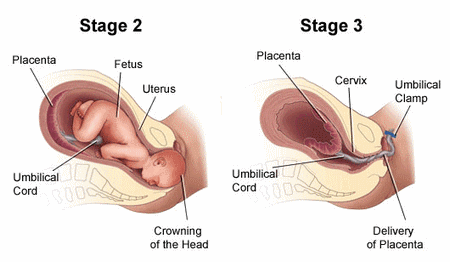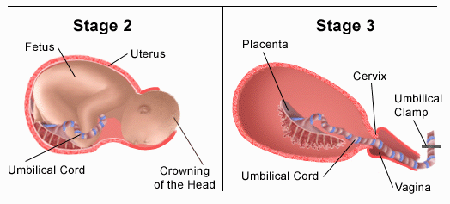Best Way to Understand the Second and Third Stage of Labor
When you’re in labor, especially the transition phase, you have no concept of time. You just know you’re getting tired and don’t want to labor anymore. Finally, you hear the magic word, “Complete.” Immediately afterward, you’ll sense a change in the mood of the room. The doctor or midwife is preparing for the delivery. You may be saying to yourself, “But I feel the same, what’s different?” The answer is, your cervix has done its job. You are completely opened up, and now your baby’s head can safely come out of the uterus and into the vagina or birth canal. You will be told to push. Pushing helps the baby get lower in the birth canal as quickly as possible.
Delivery
Getting to this stage is wonderful, but you still have work to do. You won’t be having very hard contractions, but when they come, you’ll need to work with them to push your baby out. Once your baby’s head passes the pubic bone, the skin around the perineum—the soft tissue between the anal opening and vaginal opening—will stretch and bulge. The top of your baby’s head will be visible through the vaginal opening. Your baby is said to be crowning.
Sometimes at this point you and your baby will need a little help. Your doctor or midwife may make an incision in the perineum to ease the strain of the stretched skin and to prevent tearing. This makes the opening larger. The procedure is called an episiotomy. Less commonly, your doctor or midwife will carefully place forceps—spoon-shaped tongs—into your vagina to grasp the sides of your baby’s head or place a vacuum device around the top of the baby’s head to help your baby out of the birth canal.
When your baby’s head emerges, the doctor or midwife will support the head and allow the baby to twist to one side or the other. This frees up the shoulders. Once a shoulder is reachable, slight pressure will be put on the perineum to ease the shoulders out of the birth canal. Once the shoulders are out, the hips and legs usually slide out easily. After your baby is out, contractions decrease in intensity and duration.
Third Stage
The third stage of labor and delivery is the delivery of your placenta, or the “afterbirth.” The milder contractions of your uterus cause your placenta to separate from the uterus. You will be asked to give a few more pushes to get the placenta out. Sometimes your doctor or midwife may also need to do some firm massaging of your abdomen to get the uterus to release the placenta. Your placenta is inspected visually and sent to the lab for further evaluation.
Categories
Advertisements
Recent Articles
 How to Understand Bed Sizes – A Small Guide
How to Understand Bed Sizes – A Small Guide How to Select Some Must Have Kitchen Accessories
How to Select Some Must Have Kitchen Accessories Best Way to Change a Car Tire
Best Way to Change a Car Tire Best Way to Write an Affirmation
Best Way to Write an Affirmation Best Way to Take Charge of Your Financial Life
Best Way to Take Charge of Your Financial Life Best Way to Survive a Party When You Don’t Know Anyone
Best Way to Survive a Party When You Don’t Know Anyone Best Way to Stop Self Sabotaging Yourself
Best Way to Stop Self Sabotaging Yourself Best Way to Start Journal Writing
Best Way to Start Journal Writing Best Way to Speak with a Powerful Voice
Best Way to Speak with a Powerful Voice Best Way to Simplify Your Life
Best Way to Simplify Your Life Best Way to Respond to a Put-Down
Best Way to Respond to a Put-Down Best Way to Reduce Acne Breakouts
Best Way to Reduce Acne Breakouts Best Way to Recover from Dining Disasters
Best Way to Recover from Dining Disasters Best Way to Quit Your Job Gracefully
Best Way to Quit Your Job Gracefully Best Way to Make Your Own Website
Best Way to Make Your Own Website



Leave a Reply